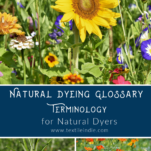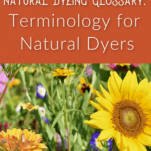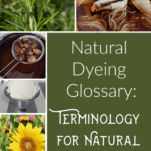This post contains affiliate links. I could be an affiliate for many different products, but I chose these specifically because they are the products and brands I like and recommend. By using my links, you help support this website.

Glossary
Absorbency – The amount a fiber can absorb or suck up and retain a liquid.
Absorption – To absorb liquid. A fiber taking on a liquid.
Acid – The level of pH on the high side of the pH scale.
Additive – Something added to a mordant to assist the mordant to adhere to the surface of a fiber.
Adjective dye – A dye that requires the use of a mordant for the dye to stick to the fiber surface.
Alkaline – Has a pH of 7 or higher. Has the properties of an alkali or contains alkali.
Alum – A mineral salt used to mordant fiber.
Auxiliary – An additional element added to a mordant bath to assist in the mordanting process.
Bark – The outer layer on the branches of trees and bushes. Some barks can be used as a dye source.
Base – Has a pH of 7 or higher. This term seems to be interchangeable with the term alkaline.
Bath ratio – The amount of materials used depending on the weight of the fiber being dyed.
Bleeding – When a color moves from one location on a fiber and spreads out from there.
Bundle dyeing – Dyeing fabric by laying organic materials on the material when laid flat and then rolling it up, tying it into a bundle, and steaming it to extract the colors onto the fabric.
Cellulose fibers – A fiber that comes from a plant. Examples: cotton, linen.
Chemical – A manufactured product used to apply color to the surface of fabric and yarns.
Cochineal – A bug sourced from South America. This bug is collected and used to create a brilliant pink dye.
🎥See video: I Tried Dyeing My Sister’s Hair with Beetles

Colorant – Used to describe the pigment that comes from dyestuff.
Color shifting – Changing the color of the dye by changing its pH.
Cool dyeing – A dyeing process using cool water.
Crocking – When a color rubs off a dyed material onto hands, clothes, or other surfaces.
Dip – To gently lower fiber, fabric, or yarn into a dye bath.
Dye concentrate – A dye in powder or liquid form with a high concentration of color and can be diluted to get different shades.
Dye extract – A natural color that has been processed so that it turns into a powder and is used in powdered form.
Dye plant – A plant that can be used to create natural dye.
Dyes – Substances used to color the surface of another object, like fiber yarn or fabric.
Dyestuff – Something that can be used as a natural dye. This includes things like leaves, nuts, flowers, bark, roots, bugs (like cochineal)
Eco dyeing – A modern term for natural dyers that use sustainable processes and materials.
🎥See video: Eco Printing – A Relaxing Showcase {Satisfying Video}

Exhaust bath – Using a mordant bath or dye bath multiple times to absorb all possible mordant or remaining dye in the pot.
Extracting – Manipulating the dyestuff to remove as much color as possible to apply to fiber.
Flowers – The colorful portion of a plant. Used as a potential dye source.
Fugitive – A natural dye that quickly fades. A color that is not lightfast or washfast.
Heat dyeing – A dyeing method using heat to extract the dye color and fix that color to the fiber.
🎥See video: DIY Natural Dyes with Heat Extraction
Husks – The outer portions of a nut or seed that has the potential for a dye.
Indigo – A plant from which a deep navy blue dye can be produced.
Iron– A possible mordant or binder to assist natural dyes adhering to a fiber surface.
🎥See video: Natural Dyeing Using Iron Water to Modify Colors
Layering – The process of dipping fiber into a dye pot repeatedly. Usually, in relation to indigo dyeing.
Leaves – The leaves from a flower, bush, or tree used to extract dye color.
Lightfastness – A color’s resistance to fading.
Litmus test – Using a pH strip to test the acidity or alkalinity of a substance.
Mellowing – When a naturally dyed fiber begins to fade slightly, and the initial brilliance of a color slightly lessens.
Mordant – A substance used to help dye bind to the surface of a fiber. Immersing fiber into a mordant bath before dyeing is used to create durable and longer-lasting natural colors.
Mordanting – A process of heating a mordant in water and adding fiber. The fiber is stirred in the mordant bath for a period of time at high heat and then allowed to cool. This mordanted material can then be dyed with natural dyes.
🎥See video: How to Mordant Wool and Silk with Alum
🎥See video: How to Mordant Cotton and Linen for Natural Dyeing
Nuts – A material that can be used to create a variety of beiges and brown colors. Nuts like acorns, walnuts, and chestnuts can be used with great results.

Organic materials – A material that has grown from the ground.
Over-reduced vat – Too much reducing agent has been added to the vat. You can add air to the vat by stirring vigorously to rebalance.
pH – This is a measurement of the quality of a liquid, like water. A high pH indicates basicity and a low pH indicates acidity.
Protein fibers – Fibers from animals or a protein plant, like soybean fiber. Examples: wool, angora, cashmere, silk.
Reducing agent – A chemical that removes excess oxygen from an indigo vat.
Root – The roots of a plant. The roots from some plants are valuable dye sources.
Saddening – When a goes from a vibrant color to a more muted color. Often, this is done using iron water to make a brighter color grayer.
Scouring – The process of preparing fiber for the natural dyeing process. This step strips fibers of oils, dirt, and other surface grime that would cause them not to absorb the color during dyeing.
🎥See video: Scouring Plant Fibers – Preparing Cotton and Linen for Natural Dyeing
Skein – Yarn wrapped around something to create a loop of yarn. The loop is then tied to hold the bundles of yarn together and then twisted and wrapped around itself to create a skein.
Solar dyeing – Adding mordanted fiber, dye materials, and water to a clear glass jar and allowing it to sit in the sun until color seeps from the dyestuff into the fiber. The sun is the heat source for this light heat bath.
🎥See video: How to Solar Dye Wool Using Food Waste
🎥See video: How to Solar Dye with Natural Dye Materials

Soy milk – A liquid created from soybeans. Soybeans are soaked in water and blended to create a milky liquid infused with soybean proteins. Used as a plant-based mordant in some dyeing processes.
Sustainability – The ability to maintain a certain activity over a long period without negatively affecting the surrounding environment or people.
Tannins – An organic chemical compound sourced from oak galls and other organic materials, is used to assist fiber to absorb mordants and thus dye more effectively.
Under-reduced vat – Not enough reducing agent has been added to the vat.
Vat dyeing – A dyeing technique used for indigo that breaks down organic materials in a combination solution to make the organic material water-soluble and work as a natural dye.
Washfastness – The ability of a dyed fiber to maintain its color after several washings.
Weight of fiber – The weight of the fiber about to be dyed. This weight is used in calculating the amount of product used for a scouring bath, the amount of mordant to use, and the amount of dye material to use. They are often referred to as WOF.
Wetting out – Soaking fibers in plain water before starting the dyeing process. Used to help the fiber take the mordant or dye evenly.













